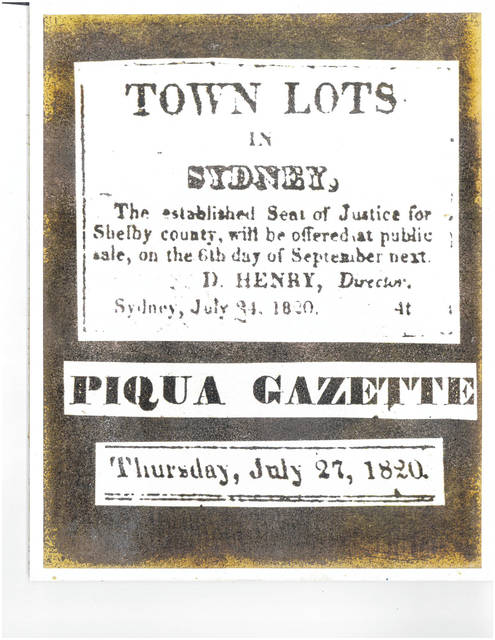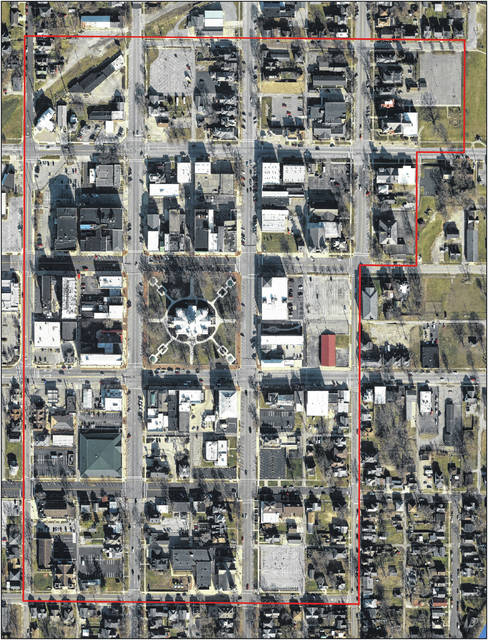

SIDNEY — In some ways, it was a real estate deal worthy of Donald Trump. Charles Sidney Starrett offered the newly installed Shelby County Commissioners, William Berry, Robert McClure and John Wilson, 70 acres of land “for the use and benefit of said county, provided the commissioners see proper to fix the seat of justice permanently” at that place.
Of course, there was additional verbiage contained in the agreement. Today, some might refer to that as the “fine print” of the document. That contractual language allowed Mr. Starrett to receive “one-half of the proceeds of the sales of the lots, after the commissioners locate, lay off, and sell the lots……..”
There was also a reserve clause that Mr. Starrett inserted in the contract. That clause provided “one acre for the public square; two half-acres for two different denominations of religious societies; one acre for each of two different denominations of religious societies for graveyards; and, one acre for the use of schools.”
It turns out that Mr. Starrett was not the only individual interested in seeing that the county seat was moved from Hardin to Sidney. Twenty-two other citizens made donations to the building of the courthouse with no other condition than the new town be located on the proposed 70-acre tract.
While most of the early town “movers and shakers” donated various sums of cash (including David Henry, William Richardson, William Robinson, Otho White, Charles Johnson, John Gilbert, John Johnston, Isaac Parks, Archibold Defrees, Benjamin Brandon, William Johnston, John Lenox, George Pool, Rodham Talbott, Edward Jackson and Alexander McClintock), William Marrs donated his large bull, Francis Rorack contributed a barrel of whiskey, George Chiles and Peter Musselman gave lumber, Thomas Ruckman contributed the sawing of the lumber into boards, and Samuel Marrs provided his carpentry skills.
The commissioners accepted the donations, and David Henry, already serving as county clerk and justice of the peace, was appointed town director. He was ordered by Common Pleas Court Judge Joseph Crane to lay off the town “in lots of five rods by ten, in blocks of eight lots each, with alleys one rod in width running though the center of each block at right angles with each other and with the streets; the alleys to divide the blocks into four equal parts; the streets to be laid out six rods in width, and a public square to be laid out in said town by striking out the center block of lots.”
Thus, by the judge’s order the town square turned out to be four acres rather than the one intended by the donor. Apparently there was not a complaint from Mr. Starrett, as the proceeds from the sale of the lots provided him the opportunity to derive far more income than would have been possible had he sold the property as a farm.
For the first several decades of her existence, Sidney consisted of 16 ½ blocks, bounded on the west by what is today Walnut Avenue (north south thoroughfares were designated as avenues), on the south by Water Street (east west roadways were designated as streets), on the north by Lane Street, and on the east, by Miami Avenue from Water Street to Popular (later Poplar) Street, east a half block to the north south alley then north to North Street, then east another half block to East Avenue (see attached map).
Although wide, the streets were unimproved. As a result, rain could quickly turn them into a quagmire; the mud was made even more detestable by the animal feces with which it was intermixed. Fortunately about 1834, gutters were installed and the streets were graveled, providing some improvement.
The sale of lots attracted the attention of a number of recently arrived immigrants, including among others, John Blake. Mr. Blake had arrived in America from England with his wife and eight children. On their way to Sidney they met Thomas English, who had also recently arrived from England. He was persuaded to accompany them to Sidney. Mr. English, a builder, accepted the Blake’s offer that they purchase for him a lot and in return he construct them a home.
Said to be the finest home within a half-day’s travel, the home Mr. English built for the Blake family was located on Popular Street on the north side of the public square. On September 11, 1820, little William Bartholomew Blake was born in that home, the first child to be born in Sidney.
In December, Mr. Blake secured a license to “vend merchandise” in his home, becoming the first storekeeper in Sidney. The following year in September, he obtained a license to be a tavern keeper, and likewise, his home became Sidney’s first bar.
The first home erected in Sidney appears to have been a log cabin. Constructed in 1819 by Abraham Cannon, it was located somewhere near the site of what is now the Cromes-Edwards Funeral Home, In addition to being Mr. Cannon’s home, it served as the meeting place for various county offices until the courthouse was built.
Although the commissioners took the necessary steps to have a courthouse and jail erected during their first meeting in Sidney, two years elapsed before the buildings were ready for occupancy. The new frame courthouse structure was two stories tall, twenty-four feet wide by thirty feet in length and was heated by fire places on either end. The attached jail was made of hewn, twelve inch square logs, two stories high with seven foot ceilings and heated by fireplaces on each level.
Both structures proved inadequate. A new jail was ordered constructed in 1825, and a new courthouse was ordered constructed in 1830. The ‘new’ jail lasted until 1839 when it was destroyed by fire. The ‘new’ courthouse lasted until 1880, when it was dismantled to make way for the construction of the current building.
Although there were a few log structures constructed in the very early days, Sidney was never a town of more than a few log homes. Saw mills made it possible for most early settlers in Sidney to have frame homes, and the first brick home appears to have been constructed in 1830.
The first brick commercial building was erected about 1830 by Joseph Cummins at the northwest corner of North Main Street and Popular Avenue, the current location of the Chase Bank building. The building was just a couple of doors east of the Cummins Family home, where General William Henry Harrison was entertained during the “log cabin and hard cider” presidential campaign in 1840.
Although there was a small log schoolhouse in Hardin in 1819, schools were considered a luxury. Even so, education was important to those early arrivals who themselves were educated, and the community’s first physician, Dr. William Pratt, had a school building constructed at his own expense in 1823 on the lot set aside for educational purposes. According to published reports, “This school house was remarkable for being built entirely of buckeye logs, except one of hackberry, and also noticeable for having a brick chimney.”
This building was used for school purposes until January 1831, when classes were classes taught in a room in the courthouse, in the Presbyterian Church (located at that time near the current location of the Downtown Barber Shop), and in the Methodist Church, located on the corner of North Street and Miami Avenue. These were private schools, some taught by ordained ministers and others by “professors” who set up shop for a year or two before being enticed to move to other communities with more students able to pay tuition.
Free schools were established in 1841, with teachers paid $75 per quarter. Out of their salaries, teachers were responsible for obtaining operational supplies, including fire wood.
From the time it became the county seat, Sidney was blessed to have a medical doctor. Unfortunately, Dr. Pratt died shortly after Sidney came into existence, and the infant community was left without a physician. The town fathers induced Dr. William Fielding to move to Sidney and practice medicine in 1824, and he remained an important part of the fabric of the community for the rest of his life.
From the time of Sidney’s earliest settlement, she has been a manufacturing center. The first businesses were mills: saw mills, grist mills, flour mills, woolen or carding mills, gin mills and distilleries.
There was a pioneer pottery, where crocks and jugs were manufactured. While axes, saws, hammer and nails could be brought into town, blacksmiths quickly set up shop to produce those items locally. Following almost as quickly were tanners, who took the pelts of wild animals and converted them to leather. Shoemakers and boot makers followed, making the leather into useful products less expensively than those same items made elsewhere and transported to Sidney for sale.
By the time Sidney celebrated her tenth birthday in 1830, there were 240 residents. That would have been a metropolis when keeping in mind that in 1830, Jackson Center was still five years away from being born. Port Jefferson was six; Lockington and Fort Loramie both seven; Russia 23 years; Botkins 28 years; Anna 38 years; and, Kettlerville 43 years away from beginning their existence.
Note: I would like to acknowledge with appreciation the assistance of Shelby County Historical Society Archivist Jane Bailey, the office of Shelby County Auditor Amy Berning, as well as published information in the Message and Reports to the General Assembly and Governor of the State of Ohio (1859), the History of Shelby County, Ohio (1883), the History of Shelby County (1913), the Memoirs of the Miami Valley (1919), the History of West Central Ohio (1934), and the History of Southwestern Ohio (1964).



